Description of need
Vision impairment can affect one or both eyes and can have widely differing implications for a child’s education.
Vision difficulties take many forms, with specific characteristics and manifestations unique to each individual child. They range from relatively minor to educationally blind.
Some children are born with vision impairment; others lose their sight, partially or completely, as a result of an illness or accident. In some instances vision impairment is only one aspect of a multiple disability.
A qualified advisory teacher of vision impairment is able to offer advice and support to families and educational settings regarding a child’s vision impairment and strategies to support access to the curriculum and the level of support will largely depend upon levels of distance and near visual acuity.
The standard definition of normal vision is 6/6. This means that a person can see at 6 metres what they are expected to see at 6 metres; the larger the number on the right, the weaker the distance vision.
The following classification applies to corrected vision (i.e. wearing glasses) with both eyes open. Acuity criteria are for guidance purposes only as children and young people may be functioning within a different vision category due to an additional ophthalmic condition. For example, nystagmus, vision field reduction, cerebral or cortical vision impairment or additional learning difficulties.
Distance vision
- mild vision loss: visual acuity within the range 6/12 - 6/18 Snellen/Kay (logMAR 0.3 –0 .48)
- mderate vision loss: visual acuity between 6/19 - 6/36 Snellen/Kay (logMAR 0.5 – 0.78)
- severe vision loss: visual acuity between 6/36 and 6/120 Snellen/Kay (logMAR 0.8 – 1.3)
- profound vision loss: visual acuity less than 6/120 Snellen/Kay (logMAR 1.32+)
Near vision
- mild vision loss: visual acuity within the range N14 – N18
- moderate vision loss: visual acuity within the range N18 - 24
- severe vision loss: visual acuity within the range N24 – N36
- profound vision loss; Educationally blind/Braille user/can access small quantities of print larger than N36
Cerebral Cortical Vision Impairment (CVI):
a condition where some of the ‘seeing’ parts of the brain and its connections are damaged and the child is unable to make sense of what they are seeing.
Perceptual difficulties:
inability to perceive, integrate and recall visual stimuli


